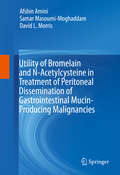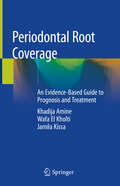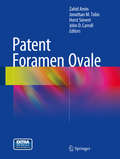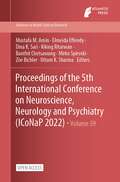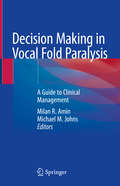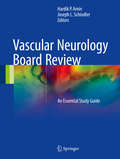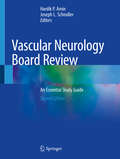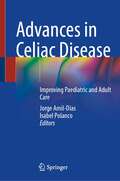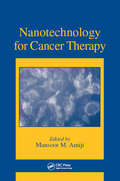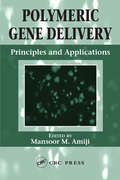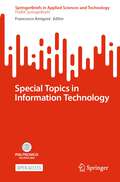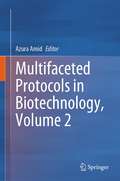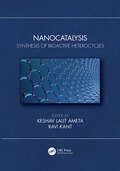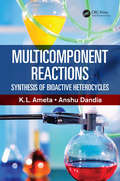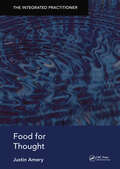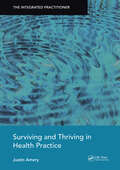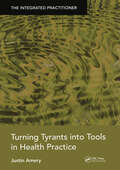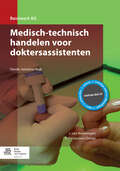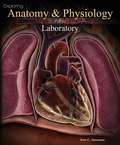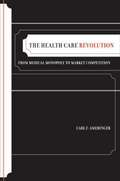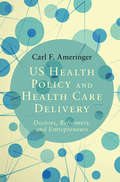- Table View
- List View
Utility of Bromelain and N-Acetylcysteine in Treatment of Peritoneal Dissemination of Gastrointestinal Mucin-Producing Malignancies
by Afshin Amini Samar Masoumi-Moghaddam David L. MorrisThis volume will describe both growth-inhibitory and mucin-depleting effects of bromelain and N-acetylcysteine, on their own or in combination, in cancer. It will coherently review the pathophysiological aspects of the mucin glycoproteins in malignancies and provide an updated account of the status of bromelain and N-acetylcysteine in cancer therapy. The volume will develop the idea of using these two drugs as a combination formulation for mucin-depleting effects.
Periodontal Root Coverage: An Evidence-Based Guide to Prognosis and Treatment
by Khadija Amine Wafa El Kholti Jamila KissaThis book is an evidence-based guide to periodontal root coverage that provides up-to-date information on the etiology of gingival recession defects, prognostic factors relating to the defect, patient, or operator, and surgical techniques. Attention is drawn to critical elements in the execution of surgical procedures that can impact on outcomes. In order to ensure that the guidance reflects the highest level of evidence, the authors have undertaken an exhaustive literature search of the four main electronic databases (MEDLINE/PubMed, Cochrane Library, ScienceDirect, and EBSCOhost) for studies on root coverage, including randomized clinical trials, systematic reviews, meta-analyses, and network meta-analyses. The aim is to supply readers with a truly reliable source of knowledge that will help them to navigate this complex field, in which numerous surgical procedures have been described, with great variability in clinical and statistical outcomes. The book will be of value to all who wish to improve their understanding of gingival recession defects and the techniques to achieve root coverage that offer the best long-term results.
Patent Foramen Ovale
by Zahid Amin Jonathan M. Tobis Horst Sievert John D. CarrollThis book is the ultimate reference on patent foramen ovale (PFO), a defect in the septum of the heart estimated to be present in more than twenty percent of the adult population and a proven cause of systemic embolism. All chapters have been written by internationally recognized experts in the field and cover PFO genetics and anatomy in addition to the effect PFO can have on various different organs and its supposed involvement in several conditions and clinical syndromes such as migraine, diving incidence, platynea orthodeoxia, economy class syndrome, sleep apnea and persistent desaturations in mild right ventricular dysfunction. As PFO anatomy varies significantly between individuals, chapters have also been included on the diagnostic tools, methods and techniques for appropriate assessment, detection and characterization of PFO. Furthermore, the multitude of available closure devices and techniques for PFO closure are discussed together with current and ongoing trial data. The book concludes with guidance and instruction on establishing a successful PFO program. Patent Foramen Ovale will be an essential text for the whole adult and pediatric interventional community, general cardiologists, internists, primary care physicians, neurologists and device companies in addition to medical students, graduate students and fellows in training.
Proceedings of the 5th International Conference on Neuroscience, Neurology and Psychiatry (Advances in Health Sciences Research #59)
by Mustafa M. Amin Elmeida Effendy Dina K. Sari Kiking Ritarwan Banthit Chetsawang Mirko Spiroski Zöe Bichler Uttam K. SharmaThis is an open access book.Neuroscience is an emerging branch of science that develops rapidly. It needs neurology, psychiatry, and psychology for us to understand it better. The aim of this conference is to educate and learn the current trends and research in neuroscience education. The 5th International Conference on Neuroscience, Neurology and Psychiatry (ICoNaP) 2022 is a conference held by The Faculty of Medicine of Universitas Sumatera Utara for psychiatrists, neurologists, general practitioners, and other interested specialists; the theme for this year is “Exploring the Neuroscientific Impact of Covid-19”.ICoNAP has been held annually since 2018. The conference invites both national and international speakers from many countries. Throughout these years the committee has invoted various speakers from Malaysia, Singapore, Germany, Australia, India, Thailand, the USA, France, and Malaysia. This year, we invite both national and international speakers from the United Kingdom, Japan, Australia, Singapore, and Malaysia and will be held as a virtual conference.
Decision Making in Vocal Fold Paralysis: A Guide to Clinical Management
by Milan R. Amin Michael M. JohnsThis guide brings thought leaders and master clinicians together to share their wisdom and expertise regarding clinical decisions surrounding unilateral and bilateral vocal fold paralysis. Designed as a what- to-do and why as opposed to a how-to guide, the authors detail the reasoning process from work up, through intervention, to post-treatment decision making. The text is organized around decision points in the management of vocal fold paralysis such as decisions in regard to timing, intervention, implants, reinnervation, drugs, voice therapy, and post-operative care. Individual chapters focus on specific steps in the process of evaluation and treatment, explore the decisions that can and should be made, and provide answers and direction for the reader. Authors explain the issues around the decision point and use their considerable experience to offer their opinion and as well as the thought process behind it. Decision Making in Vocal Fold Paralysis will be a useful guide for practitioners that deal with vocal fold paralysis, including otolaryngologists, general surgeons, neurologists, speech language pathologists, primary care physicians, and oncologists.
Vascular Neurology Board Review
by Hardik P. Amin Joseph L. SchindlerThis concise, yet comprehensive review covers the diagnostic and treatment information needed for the vascular neurology board exam. The assembled material is easy-to-read with chapters emphasizing clinically relevant scientific principles that must be mastered by the stroke clinician. Neurology, vascular neurology and neuro-critical care residents and fellows will find this text to be an invaluable preparation guide and a succinct source to complement treatment guidelines and protocols.
Vascular Neurology Board Review: An Essential Study Guide
by Hardik P. Amin Joseph L. SchindlerThis book provides a concise review for practitioners in preparation for the Vascular Neurology Boards including the Maintenance of Certification exam. This valuable second edition is expertly written and supplemented with new treatment paradigms as well as new and updated trial results.. Beginning with a general overview on how to prepare for the exam, this practical guide emphasizes clinically relevant scientific principles that must be mastered by the stroke clinician. Subsequent chapters review acute management of ischemic and hemorrhagic stroke, specific epidemiological risk factors, stroke pathophysiology, stroke classification, and vascular neuroanatomy. This edition also reviews cardiac and hematological considerations in stroke patients, genetic stroke syndromes, vascular malformations, cognitive disorders, stroke rehabilitation, and peri-operative stroke management. Vascular Neurology Board Review, Second Edition, is not only written to act as a guide for the neurology resident and fellow, but also as a useful framework for non-neurologists.
Advances in Celiac Disease: Improving Paediatric and Adult Care
by Jorge Amil-Dias Isabel PolancoThis book provides a practical overview of the treatment and management of celiac disease. It examines new data which can be merged with clinical aspects to provide a global perspective for the busy clinician. The disease represents 1% of the population and often goes unnoticed for a long time; however, this book aims to reduce the instance of misdiagnoses of symptoms by providing clear guidance in a single book, with contributions from esteemed experts in the field. Advances in Celiac Disease - Improving Paediatric and Adult Care addresses the clinical characterisation of the disease, in both paediatric and adult populations. The clinical symptoms are clearly defined as well as treatment options and follow-up. This book will be an essential resource for clinicians seeking a clear, concise resource to identifying, treating, and managing celiac disease in both adults and children.
Nanotechnology for Cancer Therapy
by Mansoor M. AmijiWhile simultaneous breakthroughs occurring in molecular biology and nanoscience/technology will ultimately revolutionize all of medicine, it is with our efforts to prevent, diagnose, and treat cancer that many of the most dramatic advances will occur. In support of this potential, the U.S. National Cancer Institute (NCI) established the Alliance fo
Polymeric Gene Delivery: Principles and Applications
by Mansoor M. AmijiTo treat disease or correct genetic disorders using gene therapy, the most suitable vehicle must be able to deliver genes to the appropriate tissues and cells in the body in a specific as well as safe and effective manner. While viruses are the most popular vehicles to date, their disadvantages include toxicity, limited size of genes they can carry
Special Topics in Information Technology (SpringerBriefs in Applied Sciences and Technology)
by Francesco AmigoniThis open access book presents outstanding doctoral dissertations in Information Technology from the Department of Electronics, Information and Bioengineering, Politecnico di Milano, Italy. Information Technology has always been highly interdisciplinary, as many aspects have to be considered in IT systems. The doctoral studies program in IT at Politecnico di Milano emphasizes this interdisciplinary nature, which is becoming more and more important in recent technological advances, in collaborative projects, and in the education of young researchers. Accordingly, the focus of advanced research is on pursuing a rigorous approach to specific research topics starting from a broad background in various areas of Information Technology, especially Computer Science and Engineering, Electronics, Systems and Control, and Telecommunications. Each year, more than 50 Ph.D.s. graduate from the program. This book gathers the outcomes of the best theses defended in 2022–23 and selected for the IT Ph.D. Award. Each of the authors provides a chapter summarizing his/her findings, including an introduction, description of methods, main achievements and future work on the topic. Hence, the book provides a cutting-edge overview of the latest research trends in Information Technology at Politecnico di Milano, presented in an easy-to-read format that will also appeal to non-specialists.
Multifaceted Protocols in Biotechnology, Volume 2
by Azura AmidThis contributed volume, “Multifaceted Protocols in Biotechnology, Volume 2”, consists of multidisciplinary methods and techniques commonly used in biotechnology studies. There are two sections covered in this book – Ionic Liquid Related Techniques & Evergreen Biotechnology Techniques. A brief introduction supports each protocol to allow easy learning and implementation. The first section consists of three chapters covering studies in modern biotechnology focusing on the role of ionic liquid techniques in extracting secondary metabolites, enzyme stabilization and biomass processing. The second section covers evergreen methodologies. It comprises five chapters covering topics on microcarrier technology for cell culture; Polymerase Chain Reaction for non-halal sources detection in food; ELISA for biomarker identification; gamma ray-induced mutagenesis for enhancing microbial fuel cells; and the effect of temperature on antibacterial activity of Carica papaya seed extract. This book will be useful to graduate students, researchers, academics, and industry practitioners working in the area of biotechnology
Nanocatalysis: Synthesis of Bioactive Heterocycles
by Keshav Lalit AmetaThe field of nanocatalysis is undergoing rapid development. Nanocatalysis can help in designing catalysts with excellent activity, greater selectivity, and high stability. Their properties can easily be tuned by tailoring the size, shape, and morphology of the particular nanomaterial. Exhibiting both homogeneous and heterogeneous catalytic properties, nanocatalysts allow for rapid and selective chemical transformations, with the benefits of excellent product yield and ease of catalyst separation and recovery. Nanocatalysis: Synthesis of Bioactive Heterocycles reviews the catalytic performance and the synthesis and characterization of nanocatalysts, examining the current state of the art and pointing the way towards new avenues of research specially synthesis of bioactive heterocycles. Top researchers summarize synthetic methodologies for the synthesis of bioactive heterocycles using a nanocatalytic framework. The catalytic performance and the synthesis and characterization of nanocatalysts are reviewed. State of the art methods and new and emerging applications of nanocatalysts in the synthesis of biologically active heterocycles are detailed. Additional features include: Focuses on designing and synthesizing nanocatalysts specifically for the synthesis of different bioactive heterocycles. Demonstrates how nanocatalysis can produce catalysts with excellent activity, greater selectivity, and high stability. Explores tuning catalysts properties by tailoring the size, shape, and morphology of a nanomaterial. Offers the reader insights into the field of nanoscience via nanocatalysis. Nanocatalysis: Synthesis of Bioactive Heterocycles is a must read for researchers in organic chemistry, medicinal chemistry and biochemistry.
Multicomponent Reactions: Synthesis of Bioactive Heterocycles
by K. L. Ameta Anshu DandiaThis timely book provides a succinct summary of methods for the synthesis of bioactive heterocycles using a multicomponent reaction (MCR) approach. The majority of pharmaceuticals and biologically active agrochemicals are heterocycles while countless additives and modifiers used in industrial applications are heterocyclic in nature. With the recent introduction of high-throughput biological evaluation, the importance of MCRs for drug discovery has been recognized and considerable efforts have been focused especially on the design and development of multi-component procedures for the generation of various bioactive heterocycles due to their significant therapeutic potential.
Noordsy's Food Animal Surgery
by N. Kent AmesNoordsy's Food Animal Surgery, Fifth Edition is a fully updated new edition of the classic field manual on surgical techniques in cattle, goats, sheep, and pigs. Designed for easy, fast access in the field, information is presented using a concise outline style with information boxes, tables, drawings, and photographs to highlight and illustrate key points Noordsy's Food Animal Surgery is an ideal reference for veterinary students and clinicians seeing food animal patients.Beginning with chapters on general surgical considerations, restraint, and anesthesia, the book's main focus is on step-by-step procedures for specific surgical techniques. The Fifth Edition has been thoroughly updated throughout to provide a current resource, with additional information on welfare, pain management, and anesthesia. Noordsy's Food Animal Surgery is an essential purchase for practitioners and students wanting to develop or refresh their surgical skills.
Co-Creating in Health Practice: The Integrated Practitioner (The\integrated Practitioner Ser.)
by Justin Amery'If...we feel better able to express and explore who we are, we may find that our health practice can also become a 'self-practice' in which we can create healthier existences for ourselves too. At the heart of it all communication is the search for brighter light, for insight, even for enlightenment. Insight illuminates darkness, listening fosters understanding, and speaking helps dispel the seeds of despair. That is the virtuous cycle that lies at the heart of effective practice.' Justin Amery This extraordinary new series fills a void in practitioner development and well-being. The books take a reflective step back from the tick-box, target-driven and increasingly regulated world of 21st century health practice; and invite us to revisit what health and health practice actually are. Building carefully on the science and philosophy of health, each book addresses the messy, complex and often chaotic world of real-life health practice and offers an ancient but now almost revolutionary understanding for students and experienced practitioners alike: that health practice is a fundamentally creative and compassionate activity. The series as a whole helps practitioners to redefine and recreate their daily practice in ways that are healthier for both patients and practitioners. The books provide a welcome antidote to demoralisation and burn-out amongst practitioners, reversing cynicism and reviving our feeling of pride in, and our understanding of, health practice. By observing practice life through different lenses, they encourage the development of efficiency, effectiveness and, above all, satisfaction. The Integrated Practitioner: Co-creating in Health Practice is the second book in the series. It focuses on communication and considers the unusual but highly powerful relationship between physicians and patients within which 'better health' is 'co-created'. It offers new ideas on various ways of communicating in practice that inspire healthier and happier existences for both patients and practitioners. Brilliantly written, practitioners, students and trainees and GP trainers will find the enlightening, witty, conversational style a joy to read.
Food for Thought: The Integrated Practitioner
by Justin AmeryEverything that exists, exists against a background. All of our experiences, beliefs and understandings of health practice derive from a living, organic and constantly moving context: whether scientific, philosophical, cultural, aesthetic, biological or spiritual. It is useful therefore to spend a little time understanding and reflecting on these building blocks of who we are. As practitioners, we don't always have time to do this...A little luxury...not essential, but hopefully a bit nourishing. Like a fireside cup of cocoa. - Justin Amery This extraordinary new series fills a void in practitioner development and well-being. The books take a reflective step back from the tick-box, target-driven and increasingly regulated world of 21st century health practice; and invite us to revisit what health and health practice actually are. Building carefully on the science and philosophy of health, each book addresses the messy, complex and often chaotic world of real-life health practice and offers an ancient but now almost revolutionary understanding for students and experienced practitioners alike: that health practice is a fundamentally creative and compassionate activity. The series as a whole helps practitioners to redefine and recreate their daily practice in ways that are healthier for both patients and practitioners. The books provide a welcome antidote to demoralisation and burn-out amongst practitioners, reversing cynicism and reviving our feeling of pride in, and our understanding of, health practice. By observing practice life through different lenses, they encourage the development of efficiency, effectiveness and, above all, satisfaction. The fifth book in this series, The Integrated Practitioner: Food for Thought, written for readers who prefer a more academic and reflective understanding of the themes of books 1-4.
Integrating Everything: The Integrated Practitioner (The\integrated Practitioner Ser.)
by Justin Amery'Health practice has always been many things, with many constraints and pressures. These things have changed over time and still vary from place to place. Being a practitioner here and now is, from one perspective, no different to the way it has always been. It involves integration. It involves weaving together many threads into one whole tapestry. It involves taking a constrained and limited palate and painting freely. It may be a science, it may be technical, it may be psychological, it may be spiritual, but it is always an art, because it integrates everything in order to create. And what we create is better health.' Justin Amery This extraordinary new series fills a void in practitioner development and well-being. The books take a reflective step back from the tick-box, target-driven and increasingly regulated world of 21st century health practice; and invite us to revisit what health and health practice actually are. Building carefully on the science and philosophy of health, each book addresses the messy, complex and often chaotic world of real-life health practice and offers an ancient but now almost revolutionary understanding for students and experienced practitioners alike: that health practice is a fundamentally creative and compassionate activity. The series as a whole helps practitioners to redefine and recreate their daily practice in ways that are healthier for both patients and practitioners. The books provide a welcome antidote to demoralisation and burn-out amongst practitioners, reversing cynicism and reviving our feeling of pride in, and our understanding of, health practice. By observing practice life through different lenses, they encourage the development of efficiency, effectiveness and, above all, satisfaction. The fourth book in the series, The Integrated Practitioner: Integrating Everything, considers the 'we', the 'me' and the 'other' perspectives of books 1-3 and integrates everything into 'health practice' as a single entity. It recognises the multifaceted nature of healthcare, its different constraints and varied pressures, but also views it from a new perspective, fostering a happier, healthier and more skilful whole within the real-life, complex and often messy world of health practice. Brilliantly written, practitioners, students and trainees and GP trainers will find the enlightening, witty, conversational style a joy to read.
Surviving and Thriving in Health Practice: The Integrated Practitioner
by Justin AmeryThis extraordinary new series fills a void in practitioner development and well-being. The books take a reflective step back from the tick-box, target-driven and increasingly regulated world of 21st century health practice; and invite us to revisit what health and health practice actually are. Building carefully on the science and philosophy of health, each book addresses the messy, complex and often chaotic world of real-life health practice and offers an ancient but now almost revolutionary understanding for students and experienced practitioners alike: that health practice is a fundamentally creative and compassionate activity. The series as a whole helps practitioners to redefine and recreate their daily practice in ways that are healthier for both patients and practitioners. The books provide a welcome antidote to demoralisation and burn-out amongst practitioners, reversing cynicism and reviving our feeling of pride in, and our understanding of, health practice. By observing practice life through different lenses, they encourage the development of efficiency, effectiveness and, above all, satisfaction. The first book in this series, The Integrated Practitioner: Surviving and Thriving in Health Practice, encourages practitioners to consider the importance of their personal position as the foundation of health practice. It inspires practitioners to consider themselves as their own most important tool', encouraging them to take better care of themselves, and provides numerous opportunities for reflection through case studies and activities.
Turning Tyrants into Tools in Health Practice: The Integrated Practitioner
by Justin Amery'In order to provide integrated healthcare, we need to integrate a huge number of...entities. Each one of these entities can be a useful tool for our practice. To be effective practitioners, we hope to gain some mastery of them. But sometimes we feel as if they have mastery of us. There are days when we feel on top of our game, we keep to time, we know instantly what's wrong, the right treatment is immediately to hand, our colleagues are supportive and helpful, and birdsong drifts through our open summer window. Then there are the other days...' Justin Amery This extraordinary new series fills a void in practitioner development and well-being. The books take a reflective step back from the tick-box, target-driven and increasingly regulated world of 21st century health practice; and invite us to revisit what health and health practice actually are. Building carefully on the science and philosophy of health, each book addresses the messy, complex and often chaotic world of real-life health practice and offers an ancient but now almost revolutionary understanding for students and experienced practitioners alike: that health practice is a fundamentally creative and compassionate activity. The series as a whole helps practitioners to redefine and recreate their daily practice, in ways that are healthier for both patients and practitioners. The books provide a welcome antidote to demoralisation and burn-out amongst practitioners, reversing cynicism and reviving our feeling of pride in, and our understanding of, health practice. By observing practice life through different lenses, they encourage the development of efficiency, effectiveness and, above all, satisfaction. The third book in the series, The Integrated Practitioner: Turning Tyrants into Tools in Health Practice explores the relationship between practitioners and their tangible, external tools such as time, computers, money, information, colleagues, equipment, targets and office spaces, along with less tangible elements like knowledge, understanding, language, values and beliefs. These tools can be of great benefit when fully integrated and balanced but they often end up controlling practitioners, dictating the manner in which the practice operates and ultimately reducing efficacy. It suggests ways for practitioners to harness the positive forces of these tools and regain control. Brilliantly written, practitioners, students and trainees and GP trainers will find the enlightening, witty, conversational style a joy to read.
Medisch-technisch handelen voor doktersassistenten
by J. Van Amerongen F. Hersevoort-ZomerDoktersassistenten verrichten veel handelingen op het gebied van de individuele gezondheidszorg. In dit boek worden daarvan de meest voorkomende medisch technische handelingen uitgewerkt. Daarbij is zoveel mogelijk uitgegaan van de beschikbare beroepsstandaarden. De handelingen worden waar nodig visueel ondersteund met foto’s en gevolgd door handige praktijktips. Aan bod komen onder andere hoofdstukken over veilig werken, instrumentenkennis, medicatie toedienen, onderzoeken en behandelingen. Door transfer van de beschreven technieken is dit boek te gebruiken in de diverse werkvelden (huisartsenpraktijk, jeugdgezondheidszorg, arbodienst en polikliniek).
Exploring Anatomy & Physiology in the Laboratory
by Erin C. AmermanMany years ago, when I first started teaching anatomy and physiology, my biggest frustration with the course came from the laboratory. It seemed as if I were pulling teeth to get my students interested in the lab material and most students were unable to make the connections between lecture and lab.
Aquinas on the Beginning and End of Human Life
by Fabrizio AmeriniIn contemporary discussions of abortion, both sides argue well-worn positions, particularly concerning the question, When does human life begin? Though often invoked by the Catholic Church for support, Thomas Aquinas in fact held that human life begins after conception, not at the moment of union. But his overall thinking on questions of how humans come into being, and cease to be, is more subtle than either side in this polarized debate imagines. Fabrizio Amerini--an internationally renowned scholar of medieval philosophy--does justice to Aquinas's views on these controversial issues. Some pro-life proponents hold that Aquinas's position is simply due to faulty biological knowledge, and if he knew what we know today about embryology, he would agree that human life begins at conception. Others argue that nothing Aquinas could learn from modern biology would have changed his mind. Amerini follows the twists and turns of Aquinas's thinking to reach a nuanced and detailed solution in the final chapters that will unsettle familiar assumptions and arguments. Systematically examining all the pertinent texts and placing each in historical context, Amerini provides an accurate reconstruction of Aquinas's account of the beginning and end of human life and assesses its bioethical implications for today. This major contribution is available to an English-speaking audience through translation by Mark Henninger, himself a noted scholar of medieval philosophy.
The Health Care Revolution: From Medical Monopoly to Market Competition
by Carl F. AmeringerThis book explains how the revolution of America's market-based health care system came into being when the U.S. Supreme Court and Congress prompted the antitrust agencies of the federal government to change the rules of the health care system. Ameringer lays out the key events that led up to this regime change; explores its broader social, political, and economic contexts; examines the views of both its proponents and opponents; and considers its current trajectory.
US Health Policy and Health Care Delivery: Doctors, Reformers, and Entrepreneurs
by Carl F. AmeringerThe unique composition and configuration of doctors and hospitals in the US is leading to a crisis in primary care provision. <P><P>There are significantly more specialists than generalists, and many community hospitals and outpatient facilities are concentrated in affluent areas with high rates of comprehensive insurance coverage. These particular features present difficult challenges to policymakers seeking to increase access to care. Carl F. Ameringer shows why the road to universal healthcare is not built on universal finance alone. Policymakers in other countries successfully align finance with delivery to achieve better access, lower costs, and improved population health. <P>This book explains how the US healthcare system developed, and why efforts to expand insurance coverage in the absence of significant changes to delivery could make things worse.
